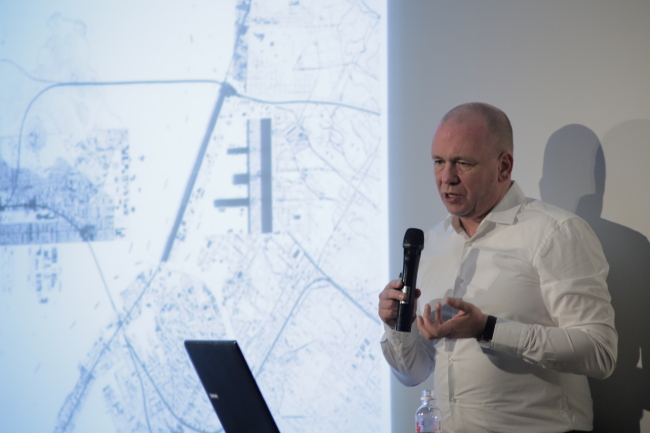A conventional, rectangular office building may not seem like an attractive design choice when major cities compete to build iconic skyscrapers as symbols of their economic growth.
But Reinier de Graaf, partner of the Office for Metropolitan Architecture, founded by architect Rem Koolhaas, says the simple form will ironically stand out among other stylish buildings.
“When everything is exciting, a non-exciting (design) becomes exciting,” said de Graaf at a public lecture at Daelim Museum in Seoul on Thursday, pointing at a computer-generated image of a massive, but plain-looking, building standing amid iconic skyscrapers from all around the world, such as the Petronas Towers in Kuala Lumpur and Burj Al Arab in Dubai.
 |
Reinier de Graaf, partner of the Office for Metropolitan Architecture, speaks at a lecture in Seoul on Thursday. (Daelim Museum) |
This simple building design, “Dubai Renaissance,” was OMA’s entry for a competition for an iconic central feature at Business Bay in Dubai in 2006. It was never built, but it set the architectural direction for the firm, according to de Graaf.
“So far, the 21st-century trend in city building has led to a mad and meaningless overdose of themes, extremes, egos and extravagance,” the OMA said in describing its motive for the building design. “What is needed is a new beginning.”
The OMA said that the building was environmentally sustainable, as it wastes no energy. The tower -- 200 meters wide and 300 meters tall -- boasts a massive presence in the front, in contrast to its surprisingly slender volume when seen from the side.
De Graaf said that only 10 percent of the designs drawn by the office are ever built, but the designs of unrealized projects often become inspirations for other projects.
One of the unrealized designs that has inspired many other buildings was the 1996 design for the Samsung headquarters building in Dogok-dong, Seoul, which featured three independent towers connected at the bottom, with connecting floors at a higher level for efficient circulation and movement inside the towers.
Although the design was not realized, the concept of connecting independent buildings was later realized in De Rotterdam, the largest building in the Netherlands, completed in 2013.
The three 150-meter-high towers accommodate a variety of functions, ranging from offices, apartments, hotel and shops to restaurants and cafes. As in the design for the Samsung headquarters, the towers are interconnected, with shared space at the middle levels that function as lobbies for each tower and general foot-traffic hubs for visitors.
“Buildings have played enormous roles in the economy and economic growth,” said de Graaf.
“Now the trend is toward sustainable, responsible behavior of growth. That goes both for buildings and cities.”
In Korea, the OMA has designed one of the three buildings of the Leeum, Samsung Museum of Art and the Seoul National University Museum of Art, both relatively small projects compared to the firm’s large-scale projects elsewhere.
Yet the unrealized buildings and projects designed for Korean projects continue to have major influences on the OMA’s later projects, including the concept of aeropolis, which was first conceptualized in the 1995 commission for a city near Incheon International Airport.
“We are much more indebted to Korea compared to the size of the two buildings in Korea,” de Graaf said.
The OMA has designed major building projects and city plans around the world. Its recent major building works include the CCTV headquarters in Beijing, its biggest building to date, the Shenzhen Stock Exchange and the Timmerhuis, a mixed-use building, in Rotterdam.
By Lee Woo-young (
wylee@heraldcorp.com)








![[Today’s K-pop] Blackpink’s Jennie, Lisa invited to Coachella as solo acts](http://res.heraldm.com/phpwas/restmb_idxmake.php?idx=644&simg=/content/image/2024/11/21/20241121050099_0.jpg)